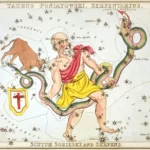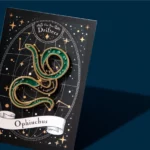The Constellation of Ophiuchus: A Guide to Its Stars and Meaning
Look up at the night sky and you’ll be greeted by a celestial wonderland of stars and constellations. One of the lesser-known but fascinating constellations is Ophiuchus. Steeped in history, mythology, and astrological significance, Ophiuchus holds a wealth of secrets waiting to be explored. In this comprehensive guide, we delve into the captivating world of Ophiuchus, uncovering its rich history, astronomical features, and the stars that make it shine. We’ll also explore its significance in astrology, ancient wisdom, and modern interpretations. So, whether you’re a stargazing enthusiast or simply curious about the mysteries of the cosmos, join us as we embark on a journey through the constellation of Ophiuchus.
Contents
- Overview of the Ophiuchus Constellation
- Exploring the Stars of Ophiuchus
- The Significance of Ophiuchus in Astrology
- Ancient Wisdom and Modern Interpretations
- Conclusion
-
Frequently Asked Questions
- 1. What is the meaning behind the name “Ophiuchus”?
- 2. How can I locate the Ophiuchus constellation in the night sky?
- 3. What is the significance of the Barnard’s Star in Ophiuchus?
- 4. Is Ophiuchus considered a zodiac sign?
- 5. What are the personality traits associated with Ophiuchus?
- 6. How does Ophiuchus compatibility with other zodiac signs?
- 7. Can you tell me more about the historical astrological references to Ophiuchus?
- 8. How popular is Ophiuchus in contemporary astrology?
- 9. Is there a specific mythology or folklore associated with Ophiuchus?
- 10. Are there any cultural variations in how Ophiuchus is perceived?
- References
-
Frequently Asked Questions
- 1. What is the history and mythology behind the Ophiuchus constellation?
- 2. How can I identify the Ophiuchus constellation in the night sky?
- 3. What are some notable features and stars within the Ophiuchus constellation?
- 4. Is Ophiuchus considered as the 13th zodiac sign?
- 5. What are the personality traits and characteristics associated with the Ophiuchus sign?
- 6. How compatible is the Ophiuchus sign with other zodiac signs?
- 7. Are there any ancient references to Ophiuchus in astrology?
- 8. How popular is Ophiuchus in contemporary astrology?
- 9. What is the meaning and significance of the star Alpha Ophiuchi?
- 10. What ancient wisdom can we learn from the Ophiuchus constellation?
- References
- Read More
Overview of the Ophiuchus Constellation
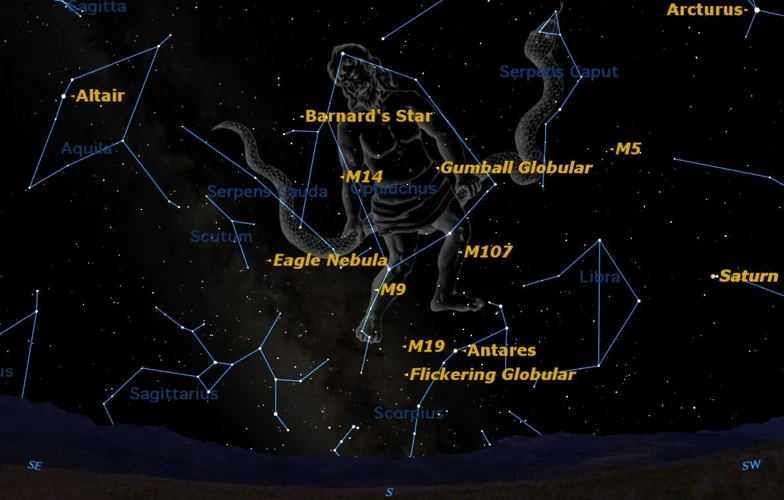
The Ophiuchus constellation, also known as the “Serpent Bearer,” is a unique and intriguing formation in the night sky. Here, we explore the history, mythology, and astronomical features that make Ophiuchus a captivating constellation.
In ancient Greek mythology, Ophiuchus represents the legendary healer Asclepius. Asclepius was known for his remarkable ability to heal the sick and even bring the dead back to life. This made him incredibly powerful, causing concerns among the gods. To maintain the balance between life and death, Zeus decided to strike Asclepius down with a lightning bolt, transforming him into a constellation.
Ophiuchus is located near the celestial equator, making it visible from most parts of the world. It lies between the constellations of Serpens and Hercules and is often depicted as a man holding a serpent. This serpent is represented by the adjacent constellation Serpens, which is further divided into two parts: Serpens Caput (the head) and Serpens Cauda (the tail).
Ophiuchus is also home to several interesting celestial objects. One notable feature is the Barnard’s Star, which is one of the closest stars to our solar system. Additionally, there are several binary star systems within Ophiuchus, where two stars orbit around a common center of mass. These features make Ophiuchus a fascinating constellation to explore for both amateur and professional astronomers.
By delving into the rich history and astronomical features of Ophiuchus, we gain a deeper understanding of this enigmatic constellation. In the next section, we will take a closer look at the individual stars that contribute to the brilliance of Ophiuchus.
1. History and Mythology
The history and mythology surrounding the Ophiuchus constellation are as captivating as the stars themselves. In ancient Greek mythology, Ophiuchus is associated with the healer Asclepius, who was believed to possess extraordinary healing abilities. Asclepius was the son of Apollo and was renowned for his knowledge of medicines and remedies. Legend has it that he was able to revive the dead, a skill that both astounded and alarmed the gods. The enraged Zeus struck Asclepius down with a thunderbolt, and in honor of his contributions and achievements, immortalized him in the night sky as the constellation Ophiuchus.
Throughout history, different cultures and civilizations have attached their own significance and meaning to Ophiuchus. In Egyptian astrology, Ophiuchus is often linked to Imhotep, the physician and builder of the step pyramid of Saqqara. Imhotep was revered as a healer and believed to possess divine wisdom.
In recent years, Ophiuchus has gained attention for its association with the 13th zodiac sign. This concept suggests that there might be an additional zodiac sign between Scorpio and Sagittarius, with Ophiuchus taking its place. While traditional Western astrology does not recognize Ophiuchus as an official zodiac sign, this notion has sparked discussion and intrigue among astrology enthusiasts.
The history and mythology surrounding Ophiuchus highlight its prominence in different belief systems and cultures. It is a constellation that embodies the power of healing, wisdom, and transformation. To further explore the relationship between Ophiuchus and mythology or to learn more about the constellation’s deities, refer to our article on Legends and Deities of Ophiuchus.
2. Astronomical Features
Ophiuchus, the Serpent Bearer, is not only rich in mythology but also possesses intriguing astronomical features. One noteworthy celestial object in this constellation is the Barnard’s Star. It is a red dwarf star located approximately 5.9 light-years away from our solar system, making it one of the closest stars to us. Although it may appear faint in the night sky, Barnard’s Star has drawn the attention of astronomers due to its high proper motion, meaning it moves relatively quickly across the sky. Its proximity to Earth and intriguing characteristics make it a subject of interest for scientific study and exploration.
Within the boundaries of Ophiuchus, there are also several noteworthy binary star systems. These systems consist of two stars orbiting around a common center of mass. One prominent example is the binary star system known as Yed Posterior. Yed Posterior is composed of two stars, one is a yellow giant star and the other is a white dwarf. This combination of different stellar types in a binary system adds to the fascination and complexity of Ophiuchus.
Additionally, Ophiuchus features several star clusters and nebulae that provide a breathtaking view for observers. One such cluster is the IC 4665, located in the head of Serpens Caput. IC 4665 is a relatively young open star cluster, comprised of dozens of young stars that formed from the same molecular cloud. Its beauty and arrangement make it a popular target for amateur astronomers and astrophotographers.
By studying the astronomical features of Ophiuchus, astronomers gain a deeper understanding of the constellation’s composition and explore the interconnected nature of celestial objects within. The stars, star clusters, and nebulae within Ophiuchus combine to create a captivating and visually stunning display in the night sky. As we move forward through this guide, we will explore the individual stars of Ophiuchus, shedding light on their characteristics and significance in greater detail.
Exploring the Stars of Ophiuchus
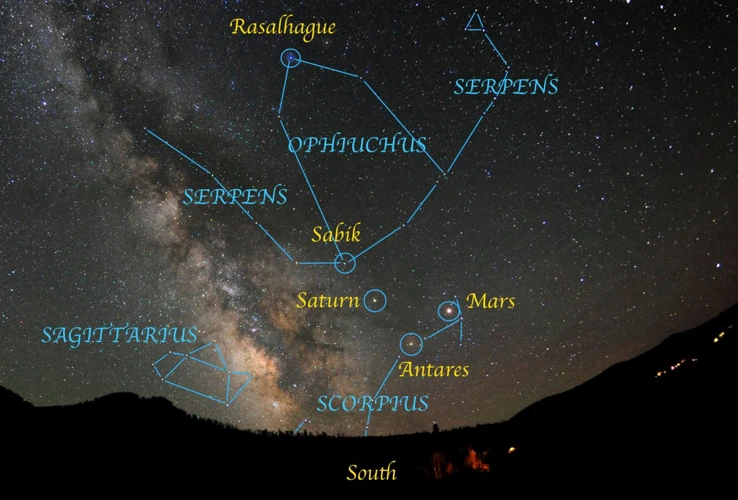
Ophiuchus is adorned with a dazzling array of stars that add to its celestial beauty. Let’s uncover some of the notable stars within this constellation:
- Alpha Ophiuchi: Also known as Rasalhague, this is the brightest star in Ophiuchus. Rasalhague is a binary star system composed of a yellow-white giant star and a smaller companion. Its name is derived from Arabic, meaning “head of the serpent.” This star has caught the attention of astronomers due to its rapid rotation.
- Rasalhague: Located in the head of the celestial serpent, Rasalhague is an Alpha-2 Canum Venaticorum variable star. This means that its brightness fluctuates over time, making it an object of interest for researchers studying stellar evolution.
- Barnard’s Star: Although not visible to the naked eye, Barnard’s Star is a significant star in Ophiuchus. It is one of the closest known stars to our solar system, located just over six light-years away. This red dwarf star has captured the curiosity of scientists as a potential target for future interstellar exploration.
- Yed Posterior: Also known as Epsilon Ophiuchi, this yellow giant star is situated near the serpent’s tail. Yed Posterior shines with a luminosity over 100 times that of the Sun. Its name is derived from the Arabic word meaning “the hind part of the hand.”
- Sabik: This binary star system is composed of two hot blue-white stars. Sabik is located in the head of Ophiuchus and exhibits a magnitude of 2.43, making it one of the brightest stars in the constellation. Its name comes from the Arabic phrase meaning “preceding one.”
Exploring the stars of Ophiuchus allows us to appreciate the diversity and wonder of the universe. Each star tells its own unique story, adding to the tapestry of this magnificent constellation. In the following section, we will unravel the significance of Ophiuchus in astrology and its connection to the zodiac.
The Significance of Ophiuchus in Astrology
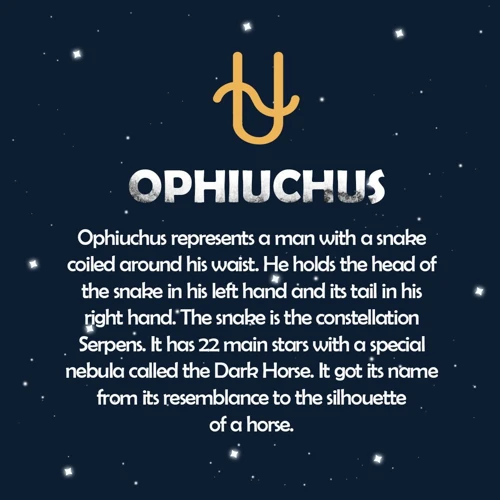
Astrology enthusiasts are familiar with the traditional twelve zodiac signs, but the addition of Ophiuchus as the thirteenth sign has sparked great interest and controversy. This newfound significance of Ophiuchus in astrology has led to discussions regarding its characteristics and compatibility with other signs.
As the 13th zodiac sign, Ophiuchus brings forth a unique set of personality traits and characteristics. Those born under this sign are often seen as wise, intuitive, and driven individuals. They possess a deep understanding of human nature and are natural healers, just like the mythological figure associated with the constellation.
Ophiuchus individuals are motivated by a desire to seek knowledge, truth, and spiritual growth. They are driven by their genuine passion for uncovering the mysteries of life and the universe. This motivation inspires them to pursue careers in healing, research, or spiritual practices, where they can make a profound impact on others’ lives.
In terms of compatibility with other signs, Ophiuchus individuals are often seen as harmonious with Cancer. Both signs are deeply emotional and intuitive, creating a strong bond through their understanding of each other’s emotional needs. To learn more about the compatibility of Ophiuchus with Cancer, you can read our in-depth guide on Ophiuchus and Cancer Relationship Compatibility.
The inclusion of Ophiuchus in astrology has sparked various discussions within the astrological community. Some embrace its addition, recognizing its potential to expand our understanding of zodiac signs and personality traits. Others approach it with skepticism, reluctant to deviate from the traditional twelve signs. Regardless, the significance of Ophiuchus in astrology has opened up new avenues for exploration and interpretation in the ever-evolving field of astrology. To delve deeper into the motivations and attributes associated with Ophiuchus individuals, you can find more information in our article on Ophiuchus Motivations.
The newfound significance of Ophiuchus in astrology has added another layer of complexity to the already intricate world of celestial interpretation. Whether you embrace the addition of Ophiuchus or prefer to stick with the traditional zodiac, understanding its significance provides a fascinating glimpse into the rich tapestry of astrological wisdom. In the next section, we will explore the historical references and modern interpretations of Ophiuchus, shedding light on its ancient significance and contemporary popularity.
1. Ophiuchus as the 13th Zodiac Sign
Traditionally, the zodiac consists of twelve signs representing different personality traits and characteristics. However, there is a growing debate about whether Ophiuchus should be considered the 13th zodiac sign. Let’s take a closer look at the arguments surrounding Ophiuchus’ inclusion in the zodiac.
Positive Points:
1. Astronomically, the sun passes through the constellation of Ophiuchus for about 18 days between November 29th and December 17th, overlapping with the dates traditionally assigned to Sagittarius and Scorpio.
2. Advocates argue that Ophiuchus represents a unique set of personality traits that are distinct from existing zodiac signs.
3. Some believe that the addition of Ophiuchus brings balance and a more accurate representation of the celestial movements during the year.
Negative Points:
1. Critics argue that the inclusion of Ophiuchus disrupts the traditional zodiac system that has been in place for centuries.
2. They claim that adding a new zodiac sign could lead to confusion and undermine the established meanings and interpretations of the existing signs.
3. Skeptics point out that the zodiac was created based on the positions of the stars thousands of years ago, and that Ophiuchus was not considered a zodiac sign in ancient astrology.
It’s important to note that astrology is a complex and deeply personal belief system that varies among individuals. Some astrologers have embraced Ophiuchus as the 13th zodiac sign, while others continue to adhere to the traditional twelve sign system. Ultimately, whether or not Ophiuchus becomes an official zodiac sign is a matter of interpretation and personal choice among astrologers and enthusiasts.
In the next section, we will explore the personality traits and characteristics associated with Ophiuchus and how they differ from the other zodiac signs.
2. Personality Traits and Characteristics
Ophiuchus, as the 13th zodiac sign, has its own unique set of personality traits and characteristics. People born under the sign of Ophiuchus are often seen as charismatic, confident, and ambitious individuals. They possess a natural gift for leadership and are not afraid to take on challenges head-on.
One prominent characteristic of Ophiuchus individuals is their deep sense of intuition. They have a remarkable ability to sense the emotions and needs of others, making them empathetic and compassionate. This innate intuition also allows them to make quick and accurate judgments, often leading to successful decision-making.
Ophiuchus individuals are known for their intelligence and thirst for knowledge. They have a great love for learning and are constantly seeking new experiences and wisdom. They are natural problem-solvers and have a knack for finding innovative solutions.
However, Ophiuchus individuals can also display a stubborn streak. Once they have set their mind on something, they can be determined and unwavering in their pursuit. This tenacity can be both a strength and a challenge, as it may sometimes lead to tunnel vision or difficulties in compromising.
In relationships, Ophiuchus individuals are often seen as passionate and dedicated partners. They value honesty and loyalty in their relationships and are willing to go the extra mile to make their loved ones feel valued and cherished. Their magnetic charisma and charm make them attractive to others, and they thrive in social situations.
It is important to remember that while these personality traits are often associated with Ophiuchus individuals, every person is unique and influenced by a combination of factors. Astrology provides a broad framework, but individual experiences and other astrological influences also shape one’s personality. In the next section, we will explore the compatibility of Ophiuchus with other zodiac signs to gain a better understanding of their relationships.
3. Compatibility with Other Signs
When it comes to compatibility with other zodiac signs, Ophiuchus, as the 13th zodiac sign, has unique relationships and characteristics. Let’s explore how Ophiuchus interacts with the other signs of the zodiac.
1. Aries (March 21 – April 19):
Ophiuchus and Aries share a fiery nature, which can create a passionate and dynamic connection. Both signs value independence and assertiveness, making them well-matched in their ambitions and drive for success.
2. Taurus (April 20 – May 20):
Ophiuchus and Taurus have a potential for a stable and grounded relationship. Both signs appreciate security and material comforts, which can create a harmonious and nurturing bond between them.
3. Gemini (May 21 – June 20):
Ophiuchus and Gemini are both intellectual and curious signs. They share a love for communication, learning, and socializing. This commonality can foster a deep mental connection and spark engaging conversations between the two.
4. Cancer (June 21 – July 22):
Ophiuchus and Cancer share a natural understanding of emotions and empathy. They both value emotional security and can create a supportive and nurturing environment in their relationship. Read more about Ophiuchus and Cancer compatibility here.
5. Leo (July 23 – August 22):
Ophiuchus and Leo can form a powerful and charismatic duo. Both signs have strong leadership qualities and a desire to be in the spotlight. Their shared passion and drive can create a vibrant and exciting relationship.
6. Virgo (August 23 – September 22):
Ophiuchus and Virgo possess analytical minds and a strong attention to detail. They share a practical nature and a desire for perfection. This similarity can lead to a harmonious and organized partnership.
7. Libra (September 23 – October 22):
Ophiuchus and Libra both value harmony and balance in their relationships. They share a love for beauty, art, and diplomacy. This can create a harmonious and aesthetically pleasing union.
8. Scorpio (October 23 – November 21):
Ophiuchus and Scorpio understand each other’s intensity and emotional depth. They share a passionate nature, which can foster a deep and transformative connection in their relationship.
9. Sagittarius (November 22 – December 21):
Ophiuchus and Sagittarius are both adventurous and free-spirited signs. They share a love for exploration, learning, and new experiences. Their shared zest for life can create an exciting and stimulating relationship.
10. Capricorn (December 22 – January 19):
Ophiuchus and Capricorn are both determined and ambitious signs. They share a practical and methodical approach to life, which can create a stable and goal-oriented partnership.
11. Aquarius (January 20 – February 18):
Ophiuchus and Aquarius share a love for intellectual pursuits and humanitarian causes. They both value freedom and individuality, which can create an intellectually stimulating and progressive relationship.
12. Pisces (February 19 – March 20):
Ophiuchus and Pisces are both compassionate and intuitive signs. They share a deep understanding of emotions and a spiritual connection. This can foster a deeply empathetic and supportive bond between them.
While compatibility is influenced by many factors beyond zodiac signs, exploring how Ophiuchus interacts with other signs can provide insight into potential strengths and challenges in relationships.
Ancient Wisdom and Modern Interpretations
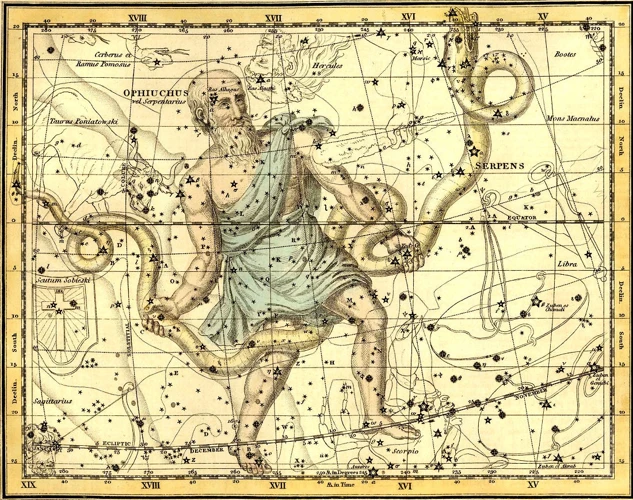
The constellation of Ophiuchus has held significant importance in ancient wisdom and continues to provoke modern interpretations. In ancient astrology, Ophiuchus was known as the 13th zodiac sign, positioned between Scorpio and Sagittarius. This additional sign introduced new perspectives on astrological characteristics and predictions. Historical astrological references mention Ophiuchus as the sign governing healing, wisdom, and transformative power. Its association with Asclepius, the Greek god of medicine, deepened its connection to healing and the pursuit of knowledge.
In contemporary views and popularity, Ophiuchus has garnered renewed attention and curiosity. Some astrologers believe that aligning with Ophiuchus as a zodiac sign can offer alternative insights into personality traits and destinies. They suggest that individuals born between November 29 and December 17 possess distinctive characteristics influenced by Ophiuchus. However, it’s important to note that mainstream astrology still recognizes the traditional twelve zodiac signs.
The modern interpretation of Ophiuchus also extends beyond astrology. Its symbolism of transformation and rebirth has found a place in various philosophical and spiritual practices. Ophiuchus is often associated with the shedding of old beliefs, embracing growth, and embracing the power of healing and renewal. It serves as a reminder of the potential for personal growth and transformation.
While ancient wisdom provides a foundation for understanding the significance of Ophiuchus, modern interpretations and popular interest have expanded its relevance. This interplay between ancient traditions and contemporary perspectives keeps the constellation of Ophiuchus a subject of intrigue and exploration.
1. Historical Astrological References
When it comes to the historical astrological references of Ophiuchus, there is a fascinating connection that reaches back to ancient times. In ancient Babylonian astrology, Ophiuchus was associated with the god Enki, who was revered as a deity of healing and wisdom. The Babylonians believed that this constellation held tremendous power and was closely associated with medicine and the art of healing.
Moving forward in history, the influence of Ophiuchus can also be seen in Egyptian mythology. The constellation was linked to Imhotep, the god of medicine and healing, who was revered as a great physician and adviser to the pharaoh. Imhotep’s association with Ophiuchus further solidifies the connection between this constellation and healing practices in different cultures.
In Western astrology, Ophiuchus is often referred to as the “13th zodiac sign.” This concept gained attention in 2011 when astronomer Parke Kunkle mentioned that due to the Earth’s axial precession, the dates of the zodiac signs need to be adjusted. This caused a surge of interest in Ophiuchus as a potential addition to the zodiac system.
While Ophiuchus does have a long-standing historical and mythological association with healing and wisdom, it is important to note that in modern Western astrology, it is not officially recognized as one of the zodiac signs. However, some individuals incorporate attributes of Ophiuchus into their astrological interpretations.
The historical astrological references surrounding Ophiuchus provide a fascinating glimpse into the different cultural perspectives on this constellation. The next section will delve into the contemporary views and popularity of Ophiuchus in modern astrology, shedding light on how it is perceived and interpreted in the present day.
2. Contemporary Views and Popularity
Contemporary views and the popularity of the Ophiuchus constellation have undergone a significant transformation in recent times. While Ophiuchus has always been recognized by astronomers and included in the celestial map, its visibility and recognition among the general public have varied.
In the realm of astrology, the inclusion of Ophiuchus as the 13th zodiac sign stirred considerable controversy. Traditionally, the Western zodiac system features 12 signs, each corresponding to a specific time of the year. However, some astrologers argue that the alignment of the Earth’s axis has shifted over time, leading to the introduction of Ophiuchus as a new sign. This sparked intense discussions regarding the implications for individuals born under this sign and the potential reevaluation of their astrological traits.
The perception and popularity of Ophiuchus have also been shaped by media and popular culture. With the rise of social media and online horoscopes, there has been an increased interest in exploring alternative zodiac signs, including Ophiuchus. People are curious to learn about the unique characteristics and personality traits associated with this newly introduced sign. However, it is important to note that the acceptance and recognition of Ophiuchus as the 13th zodiac sign vary among astrologers and enthusiasts.
The depiction of Ophiuchus in artworks, literature, and other forms of media has contributed to its growing recognition and fascination. The captivating image of the Serpent Bearer holding the serpent has captured the imagination of many, adding a touch of mystique to the constellation.
In contemporary times, Ophiuchus has found a place in popular culture, attracting attention and sparking curiosity. Whether viewed as an astrological enigma or a symbolic representation of healing and wisdom, Ophiuchus continues to garner interest and intrigue. Its presence in modern discussions about astrology and its portrayal in various forms of media have given Ophiuchus a newfound popularity that transcends its traditional role in astronomy.
As we delve deeper into the ancient wisdom and modern interpretations surrounding Ophiuchus, we uncover its enduring significance and the impact it has on our understanding of the cosmos and ourselves.
Conclusion
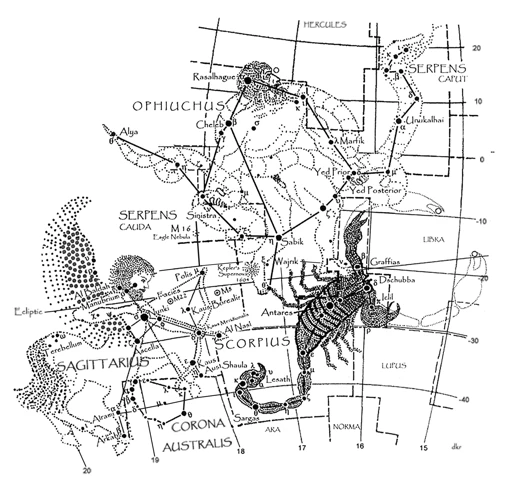
In conclusion, the constellation of Ophiuchus offers a captivating journey through history, mythology, and astrology. From its origins as the legendary healer Asclepius to its astronomical features and significance in astrology, Ophiuchus holds a special place in the celestial realm. Whether you’re a stargazing enthusiast or someone intrigued by ancient wisdom, exploring Ophiuchus opens up a world of wonder and knowledge.
The stars of Ophiuchus, such as Alpha Ophiuchi, Rasalhague, Barnard’s Star, Yed Posterior, and Sabik, add to the constellation’s allure and provide endless opportunities for observation and study. In astrology, Ophiuchus serves as the thirteenth zodiac sign, offering unique personality traits, compatibility dynamics, and a fresh perspective on interpreting the influence of the stars.
Throughout history, Ophiuchus has been both revered and overlooked, with references found in ancient texts and a resurgence of interest in contemporary times. Its symbolism and meaning continue to evolve, creating space for personal interpretations and connections.
As we conclude our guide to the constellation of Ophiuchus, we invite you to gaze up at the night sky with a newfound appreciation. Let the stories, legends, and celestial wonders of Ophiuchus inspire and ignite your curiosity about the vast universe that surrounds us. Whether you view it as a constellation anchored in mythology or a guide to understanding your astrological path, Ophiuchus offers a gateway to enlightenment, introspection, and a deeper connection to the stars above.
Frequently Asked Questions
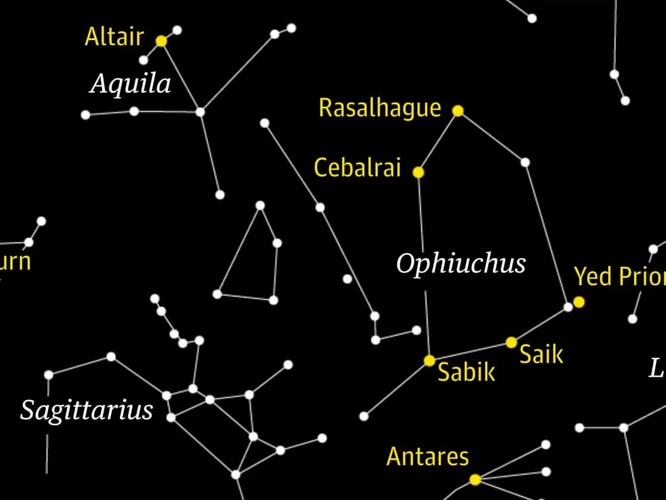
1. What is the meaning behind the name “Ophiuchus”?
The name “Ophiuchus” is derived from the Greek words “ophis” meaning serpent, and “uchus” meaning bearer. It refers to the serpent-bearing aspect of the constellation, representing the legendary healer Asclepius.
2. How can I locate the Ophiuchus constellation in the night sky?
Ophiuchus can be found between the constellations of Serpens and Hercules. Look for a curving line of stars that form the body of the Serpent Bearer, with the head pointing towards the constellation Serpens Caput.
3. What is the significance of the Barnard’s Star in Ophiuchus?
Barnard’s Star is one of the closest stars to our solar system, located around six light-years away. It is a red dwarf star known for its relatively high proper motion, meaning it moves noticeably across the sky compared to other stars.
4. Is Ophiuchus considered a zodiac sign?
While Ophiuchus is not officially recognized as one of the traditional zodiac signs, it has gained popularity and is sometimes referred to as the 13th zodiac sign.
5. What are the personality traits associated with Ophiuchus?
Those born under the sign of Ophiuchus are often described as being intuitive, wise, and possessing strong healing abilities. They tend to have a deep connection with nature and a desire to help others.
6. How does Ophiuchus compatibility with other zodiac signs?
As Ophiuchus is not widely recognized in traditional astrology, compatibility with other zodiac signs may vary. However, Ophiuchus individuals are believed to possess qualities that can complement a wide range of personalities.
7. Can you tell me more about the historical astrological references to Ophiuchus?
Ancient Babylonian and Greek astrologers made references to Ophiuchus, associating it with both healers and those with serpent-related symbolism. However, its significance in astrology has evolved over time and varies among different cultures.
8. How popular is Ophiuchus in contemporary astrology?
Ophiuchus has gained increased attention in recent years, with some astrologers incorporating it into their readings and interpretations. However, its prominence and acceptance within the broader astrological community continue to be debated.
9. Is there a specific mythology or folklore associated with Ophiuchus?
Yes, Ophiuchus is closely tied to the mythology of Asclepius, the Greek god of healing. Legends depict Asclepius as a skilled and compassionate healer, which is reflected in the constellation’s representation of the serpent-bearer.
10. Are there any cultural variations in how Ophiuchus is perceived?
Absolutely! Different cultures have their own interpretations and stories associated with Ophiuchus. For example, in Chinese astrology, Ophiuchus is associated with the constellation of the Snake and is believed to have strong intuitive and healing abilities.
References
Frequently Asked Questions

1. What is the history and mythology behind the Ophiuchus constellation?
The Ophiuchus constellation has a rich history rooted in Greek mythology. It represents the healer Asclepius, who was known for his ability to bring the dead back to life using his knowledge of medicine.
2. How can I identify the Ophiuchus constellation in the night sky?
Ophiuchus can be identified by its distinctive shape, which resembles a person holding a serpent. Look for the bright star called Rasalhague as a starting point, and then trace the arcs of stars that form the serpent and the figure of Ophiuchus.
3. What are some notable features and stars within the Ophiuchus constellation?
Within the Ophiuchus constellation, you can find several notable stars, including Alpha Ophiuchi, Rasalhague, Barnard’s Star, Yed Posterior, and Sabik. Each of these stars has its own unique characteristics and significance.
4. Is Ophiuchus considered as the 13th zodiac sign?
While Ophiuchus is sometimes referred to as the 13th zodiac sign, it is not officially recognized in mainstream astrology. The traditional zodiac consists of 12 signs, but Ophiuchus has gained some popularity in recent years.
5. What are the personality traits and characteristics associated with the Ophiuchus sign?
Ophiuchus is believed to be a wise and intuitive sign. People born under this sign are often seen as healers, with a strong desire to help others. They are also known for their curious nature, passion for knowledge, and natural leadership abilities.
6. How compatible is the Ophiuchus sign with other zodiac signs?
The compatibility of Ophiuchus with other zodiac signs is not well-defined, as it is not officially recognized in mainstream astrology. However, some astrologers believe that Ophiuchus shares traits with neighboring signs such as Scorpio and Sagittarius.
7. Are there any ancient references to Ophiuchus in astrology?
Yes, there are ancient references to Ophiuchus in astrology. The constellation was known to the ancient Greeks and was associated with the god Apollo and the healing arts. Some ancient texts also suggest that Ophiuchus may have been part of the zodiac in early astrology.
8. How popular is Ophiuchus in contemporary astrology?
While Ophiuchus has gained some popularity in recent years, it is still considered a relatively niche interest within the astrology community. Some astrologers include Ophiuchus in their interpretations, but it is not widely recognized or covered in mainstream horoscopes.
9. What is the meaning and significance of the star Alpha Ophiuchi?
Alpha Ophiuchi, also known as Rasalhague, is the brightest star in the Ophiuchus constellation. Its name means “head of the serpent bearer” in Arabic. In astrology, Rasalhague is associated with wisdom, intuition, and healing abilities.
10. What ancient wisdom can we learn from the Ophiuchus constellation?
The Ophiuchus constellation reminds us of the importance of healing, transformation, and the pursuit of knowledge. It symbolizes the power of using wisdom and intuition to bring about positive change in ourselves and others.
References
- Chandra :: Photo Album :: Constellation Ophiuchus
- Ophiuchus Constellation Facts, Stars, Map and Myth …
- Is Ophiuchus the 13th constellation of the zodiac?




